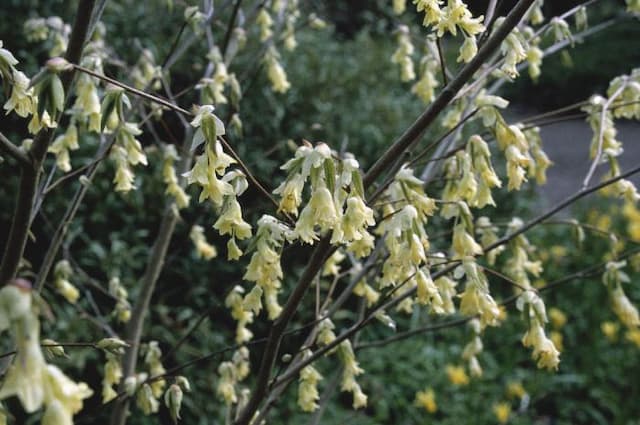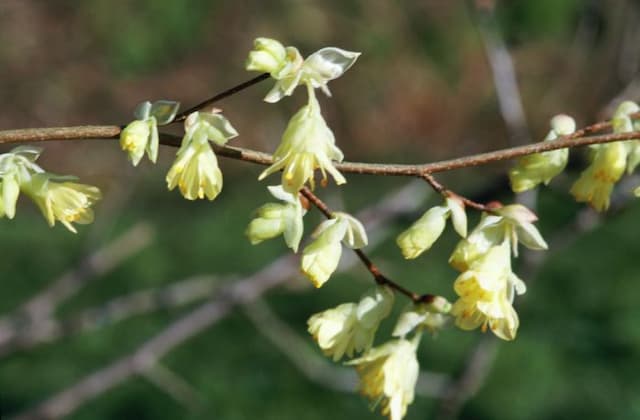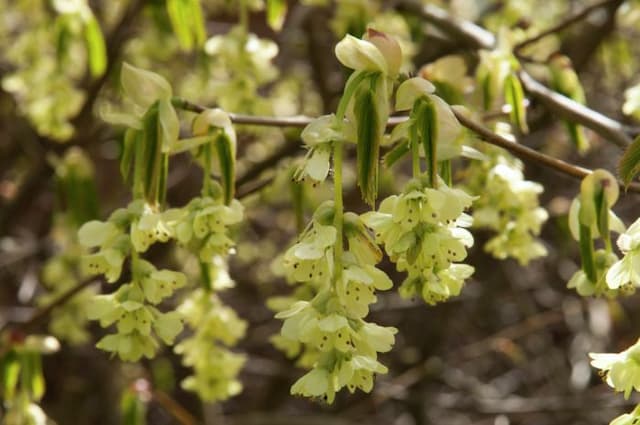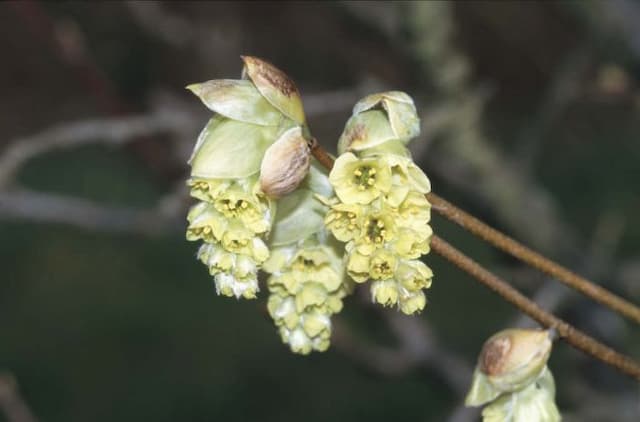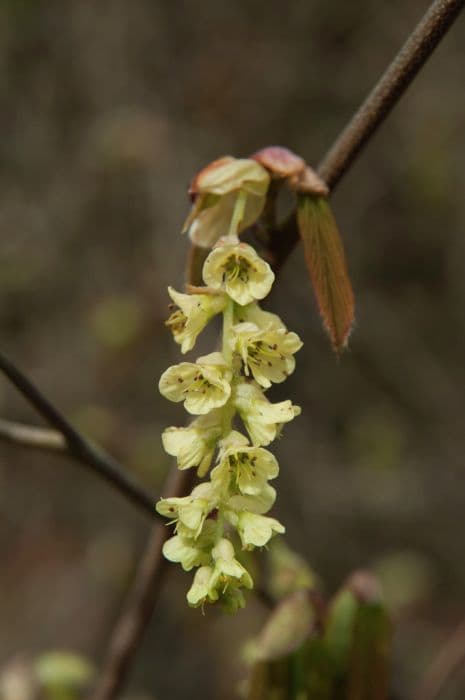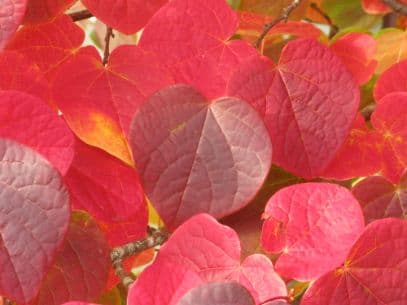Witch Hazel Hamamelis × intermedia 'Ostergold'

ABOUT
The plant commonly known as 'Ostergold' Witch Hazel features a vibrant display of yellow flowers. The petals of the blossoms are ribbon-like, slightly crinkled, and they emerge in clusters, often creating a splendid burst of color that can brighten up the winter landscape. These enchanting flowers are notable for their spidery appearance and their ability to withstand cold conditions. In addition to its showy flowers, 'Ostergold' Witch Hazel has a foliage that adds to its visual interest throughout the year. The leaves are broad and oval-shaped with a smooth texture. During the growing season, the leaves exhibit a lush green color, making the plant an attractive backdrop for other garden plants. As the seasons change, so does the foliage. In autumn, the leaves undergo a transformation, taking on spectacular shades of yellow, orange, and red before eventually falling off as the winter approaches. This shift in coloration provides an extended period of interest and makes 'Ostergold' Witch Hazel a valued plant for seasonal color. The bark of the plant is also worthy of note, with a rugged texture and a color that can provide visual interest, particularly in the absence of leaves during the dormant season. Overall, 'Ostergold' Witch Hazel presents a multi-dimensional aesthetic appeal, with its combination of distinctive, fragrant flowers, changing leaf colors, and textured bark, making it a popular choice for gardens seeking year-round interest.
About this plant
 Names
NamesFamily
Hamamelidaceae
Synonyms
Witch Hazel, Hybrid Witch Hazel, Ostergold Witch Hazel
Common names
Hamamelis × intermedia 'Ostergold'.
 Toxicity
ToxicityTo humans
Witch hazel is generally considered non-toxic to humans. There is limited information on the specific hybrid Hamamelis × intermedia 'Ostergold', but witch hazel in general does not typically pose a threat when touched or ingested in small quantities. However, it is always recommended to exercise caution and avoid ingesting plants unless they are known to be safe and are prepared correctly. Large quantities or concentrated extracts may cause stomach upset or irritation.
To pets
Witch hazel is also considered non-toxic to pets. Similar to its effects on humans, there is limited information on the specific cultivar Hamamelis × intermedia 'Ostergold', but in general, ingestion of witch hazel is not known to cause significant or serious symptoms of toxicity in pets. If an animal ingests a large amount, they might experience mild gastrointestinal discomfort, but these instances are rare. Nonetheless, pet owners should always monitor their pets and prevent them from consuming plants not meant for their diet.
 Characteristics
CharacteristicsLife cycle
Perennials
Foliage type
Deciduous
Color of leaves
Green
Flower color
Yellow
Height
12 feet (3.7 meters)
Spread
10 feet (3 meters)
Plant type
Shrub
Hardiness zones
5
Native area
Hybrid
Benefits
 General Benefits
General Benefits- Seasonal Interest - Hamamelis × intermedia 'Ostergold', commonly known as Witch Hazel, has vibrant, yellow flowers that bloom in late winter to early spring, providing color when most other plants are dormant.
- Attracts Wildlife - The blossoms of Witch Hazel can attract pollinators such as bees and butterflies early in the season when few other nectar sources are available.
- Landscaping - This Witch Hazel variant is often used in landscaping for its attractive foliage and structural growth habit, making it a focal point in gardens.
- Fall Foliage - In addition to its spring flowers, Witch Hazel offers beautiful fall foliage, with leaves turning shades of yellow, orange, and red.
- Drought Resistance - Once established, Witch Hazel is relatively drought-resistant, making it suitable for gardens in areas with less rainfall.
- Low Maintenance - This plant is generally low-maintenance, requiring minimal pruning and care once it has been properly situated in the landscape.
 Medical Properties
Medical Properties- This plant is not used for medical purposes.
 Air-purifying Qualities
Air-purifying QualitiesThis plant is not specifically known for air purifying qualities.
 Other Uses
Other Uses- Wildlife Attraction: The Witch Hazel 'Ostergold' can attract birds and beneficial insects to the garden, providing a source of food and habitat for them.
- Natural Mulch: Fallen leaves from Witch Hazel can be used as a natural mulch, providing soil enrichment and weed suppression.
- Photography: Its bright yellow flowers provide an excellent subject for nature photographers, particularly as it flowers during winter when few other plants are in bloom.
- Branches for Arrangements: Cut branches of Witch Hazel can be used in floral arrangements to add an unusual and striking element.
- Garden Sculpture: The plant's unique and sometimes contorted branch structure allows it to be used as a natural sculpture within a garden design.
- Crafts: Seed pods and branches can be incorporated into crafts or as decorative elements in wreaths and dried flower arrangements.
- Educational Tool: Witch Hazel can be used in educational settings to teach about plant propagation and hybridization due to its hybrid nature.
- Privacy Screen: When planted in a row or hedge, Witch Hazel can provide privacy to a garden area while offering seasonal interest.
- Winter Garden Interest: Use Witch Hazel to provide color and texture to a garden during the winter months, when most other plants are dormant.
- Leaves as Indicators: The leaves of Witch Hazel can be used to teach or study phenology, the study of cyclic and seasonal natural phenomena, as they change color and fall in autumn.
Interesting Facts
 Feng Shui
Feng ShuiThe Witch Hazel is not used in Feng Shui practice.
 Zodiac Sign Compitability
Zodiac Sign CompitabilityThe Witch Hazel is not used in astrology practice.
 Plant Symbolism
Plant Symbolism- Beauty: Hamamelis × intermedia 'Ostergold', commonly known as Witch Hazel, displays vibrant yellow flowers that bloom in late winter to early spring, symbolizing beauty and the appreciation of unique aesthetic qualities.
- Resilience: Witch Hazel's ability to flower during the coldest months signifies resilience and the capacity to endure challenging conditions while maintaining grace.
- Healing: Historically, Witch Hazel has been used for its medicinal properties, making it a symbol of healing and comfort, especially in traditional and home remedies.
- Hope: As one of the first plants to bloom at the end of winter, Witch Hazel represents hope and the promise of new beginnings as spring approaches.
 Water
WaterFor the Witch Hazel 'Ostergold', it's best to water deeply and less frequently to encourage strong root growth. During the growing season, water the plant with about 1 to 2 gallons of water once weekly, depending on weather conditions. In times of drought or extreme heat, increase watering to twice a week. In the fall and winter, reduce watering to when the soil feels dry to the touch. Always check the moisture level at about an inch below the surface; if it's dry, it's time to water.
 Light
LightWitch Hazel 'Ostergold' thrives in full sun to partial shade. It is best to plant it in a location where it will receive at least 4 to 6 hours of direct sunlight daily, but it can also tolerate some light afternoon shade. Avoid deep shade as it can lead to poor flowering and weaker growth.
 Temperature
TemperatureWitch Hazel 'Ostergold' is hardy in a range of temperatures, and can withstand winter lows down to around -10°F. The ideal growing temperature for this plant is between 60°F and 75°F during the day. Try to avoid exposing it to temperatures above 95°F for prolonged periods, as this could stress the plant.
 Pruning
PruningPrune Witch Hazel 'Ostergold' immediately after flowering to shape the plant and remove any crossed or damaged branches. This encourages healthy growth and better flowering for the next season. Annually pruning in late winter or early spring is typically sufficient for maintaining its natural form and promoting good air circulation.
 Cleaning
CleaningAs needed
 Soil
SoilWitch Hazel 'Ostergold' thrives in well-draining, loamy soil with a slightly acidic to neutral pH between 5.5 and 7. A mix of two-thirds loam and one-third well-rotted compost or leaf mold is ideal to provide both nutrients and proper aeration.
 Repotting
RepottingWitch Hazel 'Ostergold' being a large shrub is typically not repotted, as it's grown outdoors; young plants may be repotted every 2 to 3 years until planted in the landscape.
 Humidity & Misting
Humidity & MistingWitch Hazel 'Ostergold' prefers moderate ambient humidity but is adaptable to a range of conditions; no specific humidity level is necessary for its well-being.
 Suitable locations
Suitable locationsIndoor
Not ideal for indoor growth due to size and light needs.
Outdoor
Plant in part sun, amend soil, mulch well, water regularly.
Hardiness zone
5-8 USDA
 Life cycle
Life cycleHamamelis × intermedia 'Ostergold', commonly known as Witch Hazel 'Ostergold', first begins its life cycle as a dormant seed, which requires cold stratification to break its dormancy. After stratification, the seed germinates in spring, establishing a root system and sending up shoots to develop into a small sapling. As a young plant, Witch Hazel 'Ostergold' grows relatively slowly, producing distinctive, broad green leaves and gradually maturing into a multi-stemmed shrub. Upon reaching maturity after several years, it starts its annual cycle of flowering in late winter to early spring, with fragrant yellow flowers that emerge before the leaves. After pollination, typically by insects that are active in cooler temperatures, the plant sets fruit, which are woody capsules that mature in the fall and forcibly eject seeds several meters away. Finally, in the autumn, Witch Hazel 'Ostergold' displays its vibrant yellow fall foliage before the leaves drop, and the plant enters dormancy during the cold winter months, ready to restart the cycle with the next bloom season.
 Propogation
PropogationPropogation time
Late winter to early spring
The most popular method for propagating Witch Hazel 'Ostergold' is through softwood cuttings. This is typically carried out in late spring to early summer, when new growth is supple and not yet mature. A cutting of about 4 to 6 inches (10 to 15 cm) is taken from a healthy parent plant, ensuring that at least a couple of leaves are present. The lower leaves are removed, and the cut end is dipped into rooting hormone to encourage root development. The cutting is then planted in a pot filled with a mix of peat and perlite or sand to provide adequate drainage and support for the new roots. The cutting should be kept under a plastic cover or in a humid environment and out of direct sunlight to maintain consistent moisture while roots establish, which typically takes several weeks.
